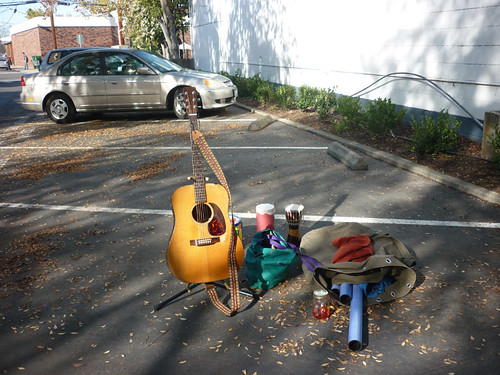 About a month ago I got a snapshot of what it might be like to live in a less fossil-fueled and growth-driven world. I had been working on an assignment for Shareable Magazine on How to Bring Transition Town-style Sharing into your Community and in the process contacted transition network groups across the globe to get more of an idea about the movement and its latest, most noteworthy and replicable inspirations and projects. It turned out the way it had to — the most enthusiastic response came from the people closest by, right down the peninsula from me, in Palo Alto.
About a month ago I got a snapshot of what it might be like to live in a less fossil-fueled and growth-driven world. I had been working on an assignment for Shareable Magazine on How to Bring Transition Town-style Sharing into your Community and in the process contacted transition network groups across the globe to get more of an idea about the movement and its latest, most noteworthy and replicable inspirations and projects. It turned out the way it had to — the most enthusiastic response came from the people closest by, right down the peninsula from me, in Palo Alto.
My first introduction to Transition Palo Alto was through Bart Anderson, a kindred spirit who responded to my initial email with a wealth of information and wisdom. Not only did he turn me on to a range of amazing people involved with TPA — from re-skilling and permaculture wizard William Mutch to “Less Is More” author Cecile Andrews — but he set the tone for my understanding of the transition movement’s essence with these words of wisdom:
The real Win comes as we develop a sharing culture in a group or community. That is, a set of attitudes and practices in which people’s “Inner Sharer” is encouraged. This culture comes about through 1000s of small things, such as people bringing goodies to meetings. People offering to give things away or help with a problem. People showing appreciation for such behavior. One of the most important things a group can do is reach out and connect. It’s not important that TPA have a project that no one else has thought of. What is important is that we are encouraging a community which values sharing and contribution.
It came as no surprise then that after a few emails back and forth, rather than continuing to theorize about a living breathing organism, Bart invited me to come down to their Holiday Sharing Expo to see for myself what all the goodness was about. If I made it to their little swap meet, he would get a bunch of transition folks to hang out afterwards and share their experiences along with some food and drink. That in itself seemed like a hard to refuse offer, but what was even more seductive to me was the thought of making a day of it and completing the SF to Palo Alto trip via bicycle and Caltrain. Deb — who had got me in touch with Bart in the first place — didn’t have to think twice to join me for the journey.
So here it is, our day of biking the train to a swap meet, or if you prefer…
Life in a Carbon-Proportionate World

Leg 1: Bike ride from the Mission District to the Downtown SF Caltrain Station
The Holiday Sharing Expo was scheduled from 11am to 12.30pm, so we got up earlyish for a scrumptious breakfast, aiming for the 10.15 Caltrain.
After putting some air in the tires…

it was time to get on our pedal horses and greet a beautiful day in the City by the Bay.
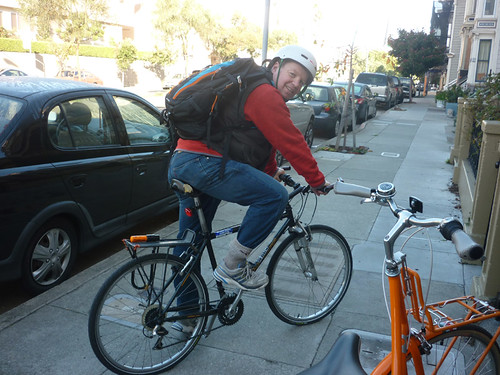
After cruising down Valencia Street we turned onto 16th, enjoying a quiet and beautiful Sunday morning going through this industrial part of town towards the bay and the Giants ballpark.

While San Francisco is still pretty much a car-centric city like most other North American cities, there have been vast improvements in bicycle infrastructure over the last few years. Little by little and street by street, the tireless advocacy of the SF Bike Coalition has been instrumental in connecting the city with a network of bike lanes that has prompted a 71% increase in bicycling just in the past five years and is aiming for 100 miles of crosstown bikeways by 2020.
It helps of course to have a City that very much realizes how crucial a bikeable and walkable city is to meet the many challenges presented by a continued automobile culture, from pollution, congestion, and traffic fatalities to shrinking oil resources and climate change. In June 2009, the San Francisco Municipal Transportation Agency (SFMTA) adopted the 2009 San Francisco Bicycle Plan, a five-year master plan and ambitious roadmap meant to boost biking to new heights of safety and convenience.
It’s this kind of policy and infrastructure change that is making it increasingly more possible for every resident young and old — not just hardcore car-dodging thrill seekers — to get around their city on a bike. To confirm that this is indeed happening I don’t even have to look at the stunning statistics — I just look at Deb on her stylin’ Public cruiser. Just a couple of short years ago, the streets of our neighborhood were just too crazy for her to feel safe and confident enough to get on a bike. Now she bikes almost everywhere, for fun and to run errands, from Rainbow Grocery all the way down to the Farmers Market at the Ferry Plaza.
If ever there was an indicator of whether a city is moving in a more sustainable direction, it’s average, non-athlete folks getting on their bikes to take care of business.
Like this one…

Bike lanes are great, of course, but there are few things more exciting for a cyclist than to stop breathing car exhaust and get off the road entirely, even for just a minute. A nice shortcut through UCSF’s new Mission Bay Campus provides welcome relief and gives a glimpse of what a city built for humans might feel like…
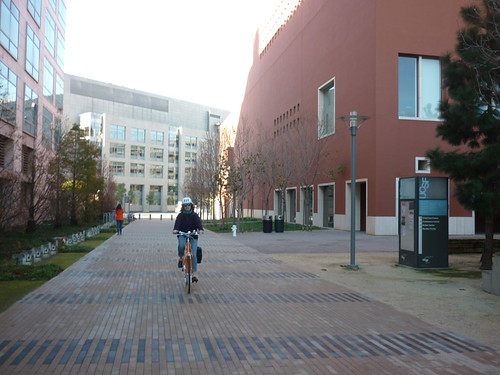
We turned north on 4th Street, which felt like a good stretch for a bike reporter self-portrait…
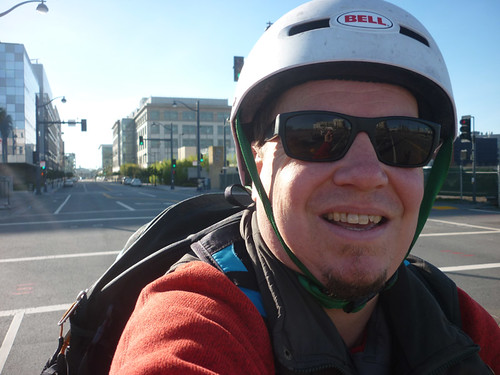
toward the Transbay Terminal…
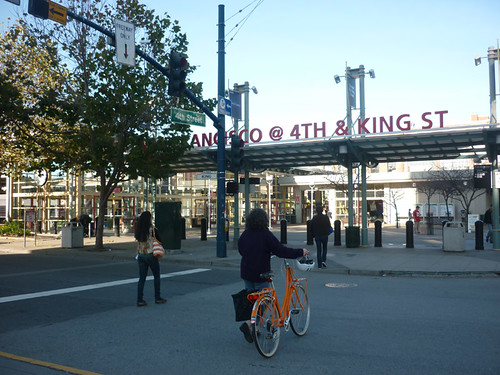
and our next mode of transportation, Caltrain…
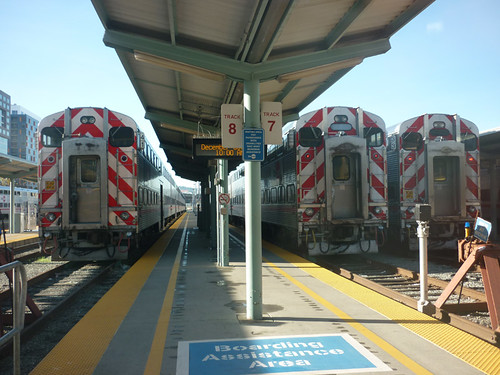
Leg 2: Bike on Caltrain from SF to Palo Alto
I don’t know about you, but I still get giddy whenever I see a train. My base instinct is to rejoice at the prospect of travel and change of scene, sitting there along with all these other passengers, looking out the window and watching the world go by. I grew up in Germany where trains were an intrinsic part of getting around, but it probably wasn’t until I visited India and had my feet dangle out the doorstep while cruising through endless rice fields and villages that I was turned on to the deeper poetry of moving on rails.
Here on the West Coast of the United States, trains aren’t so much part of the everyday landscape, though taking Amtrak from Oakland to L.A. or across the Sierra Nevada and seeing the vastness of the American west is quite a thrill. Getting High Speed Rail from SF to L.A. will not only be a huge step in providing a less fossil-fuel intensive long-distance alternative to air travel, but quite frankly it’ll be so much more fun to zone out in a spacious seat to the steady “clack, clack, clack” of a train than to be bouncing through air turbulence with your knees jammed into your chest.
But as far as already existing medium distance commuter trains, Caltrain is about as cool as it gets. As soon as you enter the station on your bike, you get the feeling they’re ready for you.
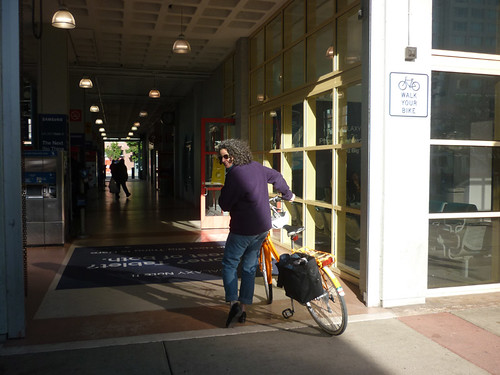
It’s so nice not to be the only one on a bike, it makes you feel just like a normal member of society…
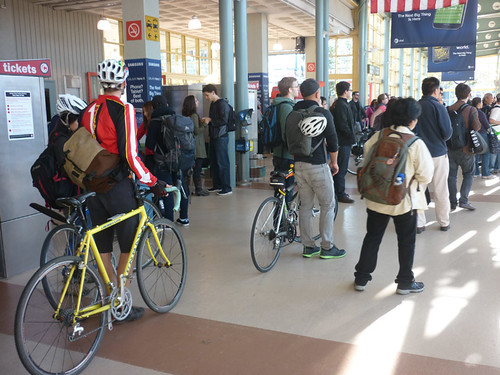
After an easy swipe of the Clipper card we’re heading out to the platform…
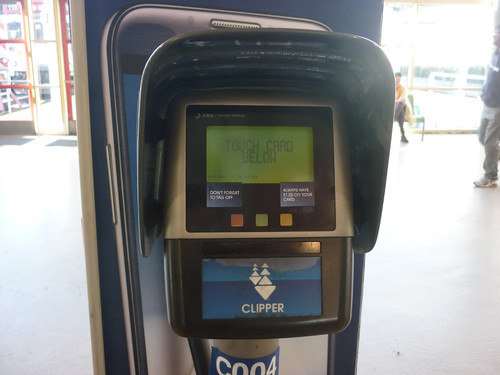
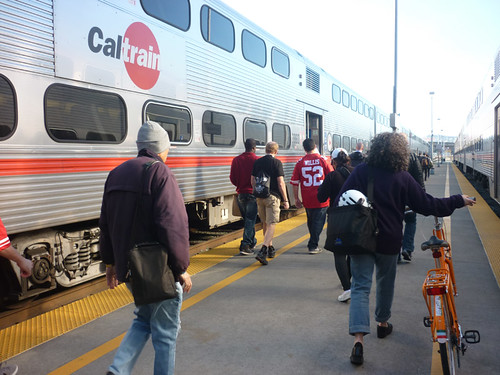
And get on one of the two bike cars…
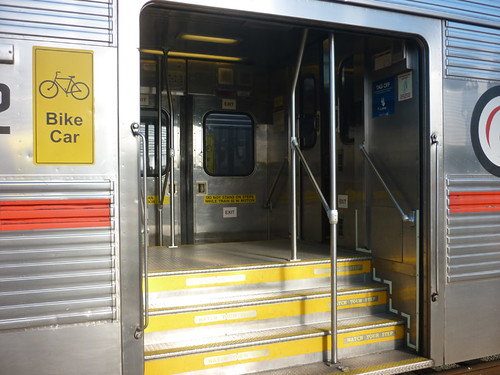
The double decker design allows us to strap our bikes on the lower level (and yes, those bike cars fill up during weekday commute hours)…
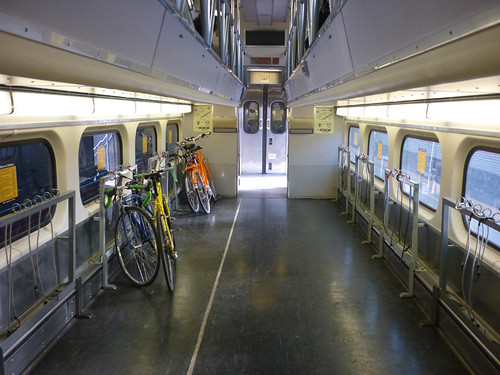
and get comfortable upstairs along with everybody else…
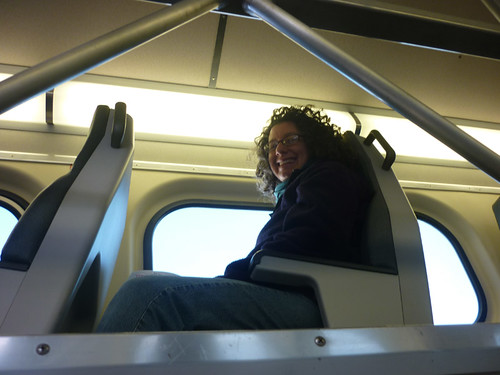
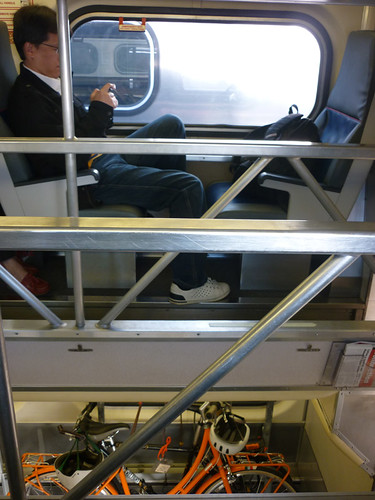
I think what people often forget when they think that giving up their cars would be such a sacrifice and life would go backwards is all the things that we gain when we get out of our cars. Yes, you might lose a little bit of flexibility, independence, and speed (though being faster by car is less and less assured the more people have cars), but I would argue that the things we gain are much more valuable:
Time to read or get some work done…
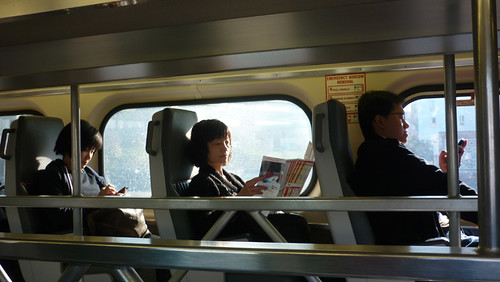
or just an opportunity to relax or watch the world go by…
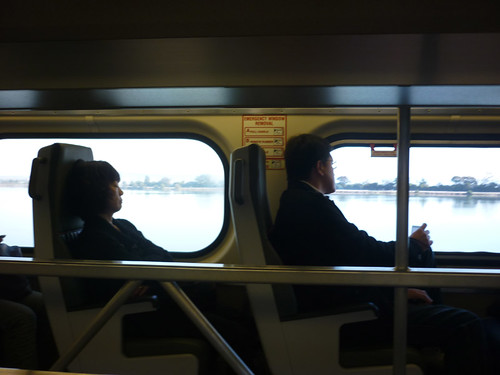
There’s just something grounding about sitting on a train that makes the idea of everyone sitting in their own 4,000 pound box of steel, plastic, rubber and all kinds of precious metals really overwhelming and out of scale.
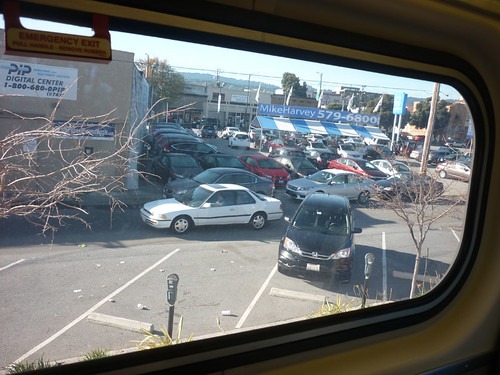
Leg 3: Holiday Sharing Expo
“The biggest contributor to happiness is social ties, and competition undermines this. So my focus is on “community conversations” where people come together looking for answers to their issues and the experience is a barn raising rather than a battle. This approach to learning helps create a “shareable” world view as well as inspires people to work for the common good.”
– Cecile Andrews, author of the forthcoming Living Room Revolution and Less Is More, Slow Is Beautiful, Circle of Simplicity
We got off at the California Ave station, riding west toward town and our destination, the parking lot behind the Common Ground Garden Supply and Education Center on College Ave.
Extra unexpected bonus: A walk though the California Ave Farmers Market…

The German in me had to stop at the Kraut stand, of course…
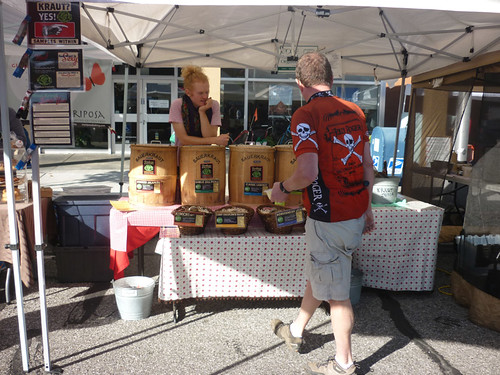
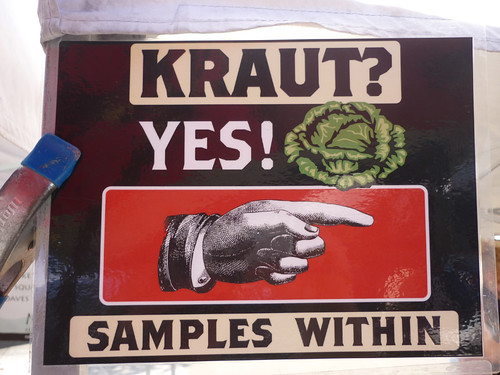
A few minutes later we arrived at the Sharing Expo. Before we could even fully enter the parking lot, we were greeted by Tom Kabat, a local bike builder who had set up a makeshift bike shop, offering free bike repair to cyclists in need.

While I had just gotten a tune up at my favorite bike shop in the city, Tom was kind enough to put a little air in my tire, something I’d failed to do in the morning.

We spotted Bart in the sunlight, chattin’ it up with some folks…

He turned out to be just as kind, generous, and intelligent in person as he’d been in our email exchanges. He invited us to look around and check out the scene while he’d get some TPA folks together that could join us for a lunch chat.
There was lots of stuff being swapped.
From books and crafts,
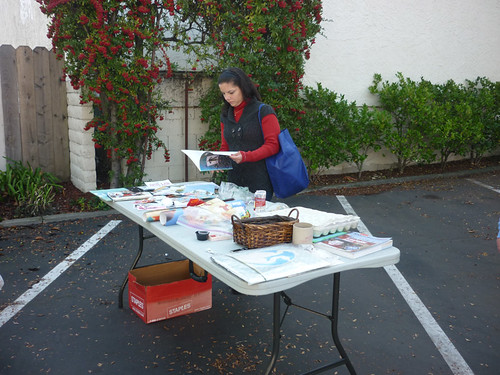
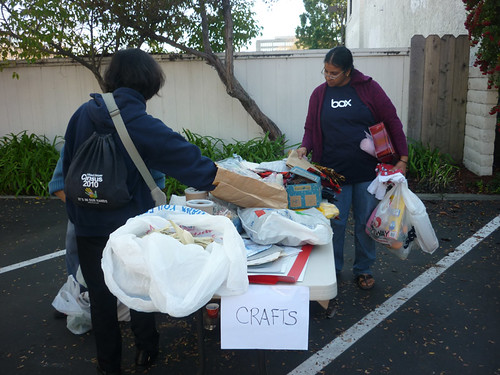
fabrics and plants,

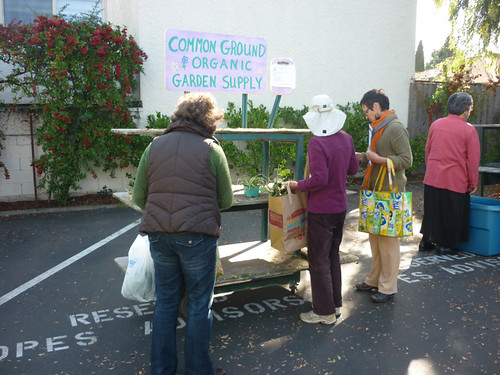
to clothing,
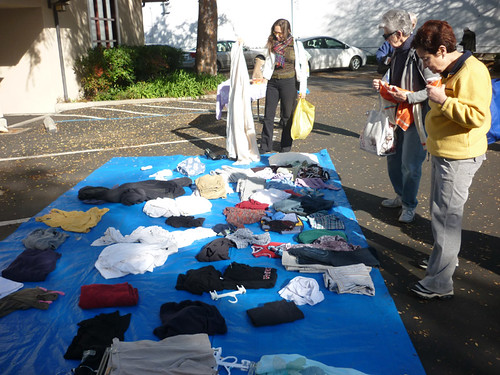
toys,

and Christmas cookies,
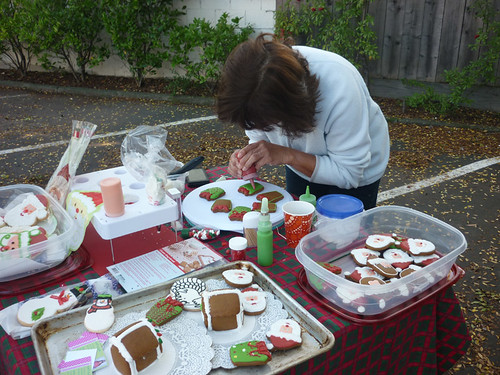
the sharing spirit was palpable. But just as Bart and Cecile had alluded to in our correspondence, the deeper meaning of it all wasn’t so much about the exchange of stuff, but the exchange of humanity. That became clear when we meandered over to the other end of the parking lot to say hi to Herb Moore, who introduced us to his Scrapophony of instruments made from glass jars, tuna cans, and PVC pipes…
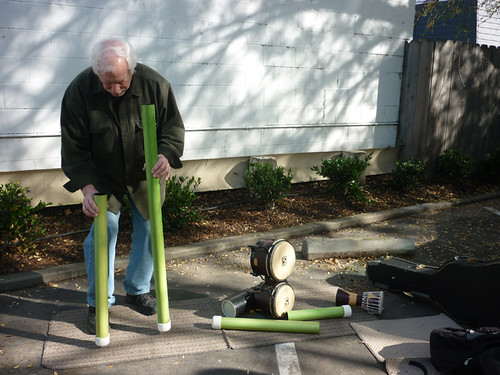
to a set of old keys…

We talked a bit about music and how it helps people focus on what’s really important, like being creative and having fun without too much stuff. Herb said that a lot of what the transition movement is trying to do is work away from the mentality of consumerism and find other ways to get your needs met.
It doesn’t mean that we all have to live like monks, as the next scene showed…
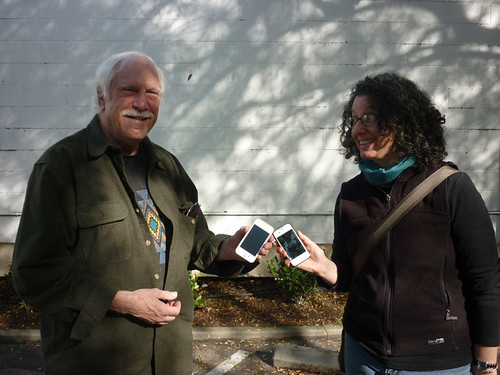
but that we cherish the things we have, take care of them, and use them wisely.
Lunchtime was approaching rapidly and Bart had spread the word that we were going to continue the conversation at a nearby cafe. And in fact, what followed almost felt like a Transition Cafe, whose top guideline is “whoever shows up are the right people.”
Well, these are the people who showed up to talk about their dreams and hopes for a more conscious, kind, and resilient humanity that will have to emerge from the unprecedented and brief era of cheap oil and quarterly profits.

It was really refreshing to get people together with the intention of talking about things that matter, both in our personal lives and in the world. And it wasn’t that everyone agreed on everything, what was important was that we all agreed to get together to share our different thoughts, concerns, ideas, and hopes. It just seems that too often in this industrialized world we are alone in our own heads, and just being able to air out the accumulated mind debris in our heads helps to come up with new insights and paths forward that we didn’t think possible on our own.
William Mutch sums up the transition spirit in his description of the transition cafe:
We’re not looking for whose approach is right, or best, but for intersections and commonalities. How do we come together, despite our differences, to help heal ourselves and the world we call home? How can our differences become pieces of a puzzle instead of bones of contention? An ancient name for a similar idea is “under one tent”, wherein representatives of as many religions and spiritualities as possible would come together to share and create together. We just do so “in one cafe.”
Leg 4: On our way home
Looking at the terrifying math of climate change, it’s easy to get caught up in the numbers, become carbon counters, and be paralyzed for fear of doing anything that might add more CO2 into the atmosphere. Concepts like post-carbon or zero-carbon, while referring to a net-zero CO2 balance where we don’t emit more than is being sequestered, are too often taken as absolutes. The oft-heard hypothetical “even if we stopped putting any carbon into the atmosphere today” is not only physically impossible to achieve for the living, breathing beings we are, but the mere proposition of such a goal is an invitation for guilt, hopelessness, and despair.
To me, a more achievable and desirable goal worth striving for would be a carbon-proportionate world. And while it’s no doubt important to take big immediate action on reducing the most egregious and gratuitous sources of CO2, transition thinking seems to be looking deeper and further, at how we can live fulfilling and constructive lives in such a carbon-proportionate world. Seems to me that if we are going to drastically reduce the wasteful usage of cheap fossil fuels we will also need to have a positive vision of how and why people would benefit from such a change. And I think the answer has much more to do with things like conversation, friendship, and inspiration than material possessions and convenience.
With those thoughts we said good-bye to our new friends and frolicked down the streets of Palo Alto…
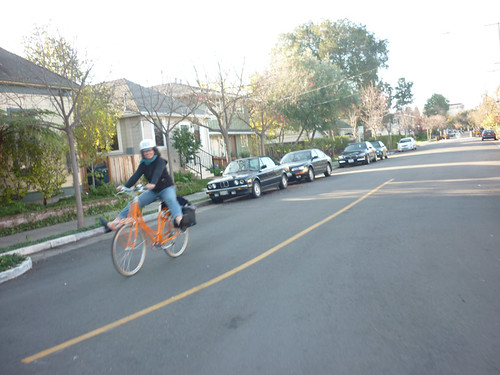
to Caltrain where I got to leisurely finish this awesome book…
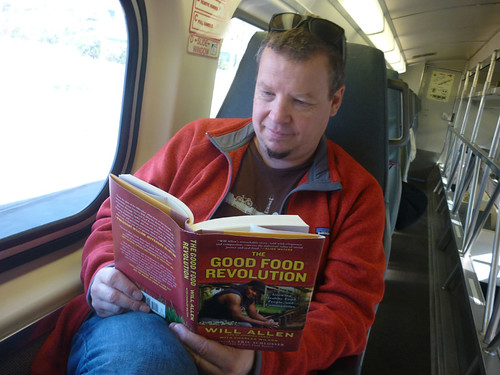
and back home to our neighborhood, where we were treated to a picture perfect ending to a picture-perfect day…




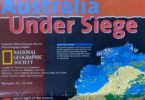




Great post…very inspiring and uplifting…Thanks for sharing…Kim
Thanks Kim. There seems to be so much depressing news, and even though all of it is part of reality I think it’s also important to pay attention to the many things that are uplifting.
I agree…I work on heath issues at a municipal level in Canada, and there are all kinds of positive things happening in communities around the world; small things that add up to healthier lives and a healthier planet! Kim
absolutely. I believe in the ripple effect. You have to have motion to create a wave.
Day tripping around the Bay Area and good company are the finer things in life.
absolutely! It’s when you really appreciate the beautiful place we live in.
Great post! As I read through it and took in the sights I had many memories of my past that I reflected on. Riding a bike in Beijing throughout the city on a virtual bicycle freeway totally segregated from the vehicular traffic. I’ve heard they’ve been dismantling it to make room for wider streets for more cars. There recent bout of air pollution and the subsequent restriction on driving shows the wisdom of that choice.
The strides our city (Seattle) is making to expand their bike paths and the ludicrous practice here to paint a bicycle emblem on the road right in the lane of traffic and call it a bike path. We’ve made great progress but still have a long way to go.
The wonderful freedom and richness of experience when you leave the car at home and bike or walk instead to your destination. When my wife and I were teaching in Thailand we would ride our bikes to school. People would wave to us along the way and we had our little stops we made both ways to pick up some provisions and connect with the neighbors. Later when we moved we started walking along the canals on our way to school. We would hear the sounds of the Thai morning awakening for a new day. The mosque would call the faithful to prayer during our journey. It was magical. Later we got a car and took to driving to school (we were further away because we moved a lot). We missed the intimacy of the prior commutes.
Ah – and the train. I love traveling by train. We often took the overnight train out of Bangkok to Koh Samui, one of our favorite island vacation spots.
Finally, I’ve been lucky enough to do quite a bit of traveling. One thing I’ve learned is the closer to the ground you go the richer your experience will be.
Five star hotels are all the same. But the home we stayed at in Nepal which cost us the equivalent of 5 cents I will never forget.
Thanks for sharing your trip.
what a nice and thoughtful comment, John. Not crappy at all. 🙂
I’ve never been to China, but I know there’s a huge and beautiful bicycle tradition there that is in the process of being wiped out by a new car culture. It’s one of those things where you think who the hell are we to tell them not to go there, but man if only you knew what you’re losing.
Your stay in Thailand sounds divine. I was there 20 years ago and enjoyed every minute of it. Land of smile, indeed. A place to forget all that’s wrong in the world for a while.
I hear you about the painting bicycles in the middle of the street. We have some of those here in SF too. Baby steps, I say, at least it sets an intention.
Hotels: I think airbnb is one of the best things to have happened to the hospitality and travel world in recent years. In fact, I stayed at a delightful place in Fremont/Ballard last year. I have yet to have a bad experience, and I’ve been doing it in several cities across North America and Europe.
A bike car! How wonderful. The design was fantastic, but just the mere idea that a “biker” is welcomed nails the encouragement approach, an aspect more important than a well-engineered train car. You’ve renewed my interest in an initiative near me in Pennsylvania (http://www.sustainlv.org/act-locally/transitions-lehigh-valley/), and I will be sure to share your post with them.
I am curious though: what were the nuances of the exchange? How was a “fair” exchange determined?
great to hear you’re involved with your local transition group, Ruth. I was really amazed how far and wide this movement has spread in my research.
As far as the nuances of the exchange, this particular one was very casual, with people just bringing what they don’t need anymore and taking what they do need. There were folks who didn’t need anything as well as folks who had nothing to give. It seemed to balance out in the overall scheme and made for a very low-pressure, non-commercial kind of setting. It’s possible that other groups have more strict swap meets where you are actually trading one thing for another, but in this case it was much more of a free for all.
To be fair, I’m not yet involved, but your post makes me realize that I should be.
Thanks for answering my question. The way my neighborhood “exchanges” big things now is we put them out at the curb –– sometimes with a free sign, usually without –– and only those brave enough to face the trash-picker stigma get the prize. I often wonder what it would be like to travel with the trash collectors to see what kind of perfectly good stuff they pick up in a day, never mind the little stuff that is stuffed into the bags.
Ruth, for some amazing trash-picking and creative inspiration, I highly recommend seeing the movie Wasteland. Perhaps not completely relevant to your situation, but it certainly takes the stigma out of “trash” picking and our own first-world worries into perspective.
I hope you do hook up with your local transition people, I have a feeling you’ll make some new friends. : )
Stop! Stop!! It’s all too nice looking and I’m envious! The notion of sharing seems so revolutionary. I thought it was supposed to be “I’ve got mine and if you don’t have yours well that’s your fault”. People really do need to experience this in order to learn what they would gain. With the bad economic scene we have had over the past decade…it seems to me even more people would be hip to this just as a practical matter. In my city by the river, we are getting more and more bike friendly and farmer’s markets are all over the place. I echo what you said about train travel. It’s the civilized way to cover long distances and we need more options for rail travel. I enjoyed the post!
yeah, I sometimes have to laugh because this whole idea of “sharing economy” is the latest big thing, and I always felt that was pretty much the only way our living together as humans worked. : )
[…] Here’s a link to Sven Eberlein’s blog post about visiting Transition Palo Alto for the Holiday Sharing Expo. https://svenworld.com/2013/01/16/biking-the-train-to-the-swap-meet-or-life-in-a-carbon-proportionate-… […]
Wow, what a wonderful post, Sven! We were so glad you could come down for the day. More is coming up … you are always welcome here.
BTW, do you think it would be okay if we re-posted your blog entry on the TPA website? Either as a whole or in part? We already have links to the blogpost and your article in Shareable.
Bart
Hi Bart, so glad you like it. Please feel free to repost the blog entry in its entirety wherever you see fit, I’d be honored.
Let’s keep in touch. I’m also on the TPA list, so I get all the updates and event invites.
Keep up all the great inspiration!
Your post made me long for The City – I lived there from 1990 – 1997. I rode my bike through GG Park a few times, and each time I came out into the traffic on either side I was totally overwhelmed. I’m so glad to hear the SF Biking Coalition is working so hard to make it more and more bike friendly.
You also reminded me of what almost everyone I talk to about biking more and cooking at home more says – that it requires planning. I don’t know why we as a culture have turned away from planning but there are so many benefits. Can’t wait to read The Good Food Revolution!
I moved to SF in 1997, Naima, so right after you left. You would definitely notice a huge difference not only in the number of bike lanes but the general attitude towards biking since then. For example, I see more and more parents with their little kids strapped onto their bikes which is really a sign that things are getting safer and there’s enough of a critical mass that drivers are also much more tuned into the addition of many cyclists on the streets. It still could be so much better and we have a ways to go before it’s truly a walkable and bikeable city, but the momentum is definitely going in the right direction.
Really great point about planning. Perhaps the reason why Americans don’t have to plan very much is because we’ve become so used to cheap energy that we never see any consequences of our ingrained wastefulness. If we had to pay the true cost of oil and gas I have a feeling we’d be less inclined to leave the lights on everywhere, heat the outdoors with heater lamps, or take multiple trips to do errands. Growing up in Germany where energy was always much more expensive and my parent’s generation experienced the hardships and shortages of war, being more thoughtful about the materials or energy we used was just part of growing up. For example, if you left your car idling on a winter morning to heat up the interior, the neighbors would be yelling at you, whereas in the US it’s just considered normal. For what it’s worth, I do think things are getting better though and Americans as a whole are becoming more conscious.
You’ll love the Good Food Revolution, it’s a great book and Will Allen is an inspiration. Thanks for stopping by and leaving such a thoughtful comment.